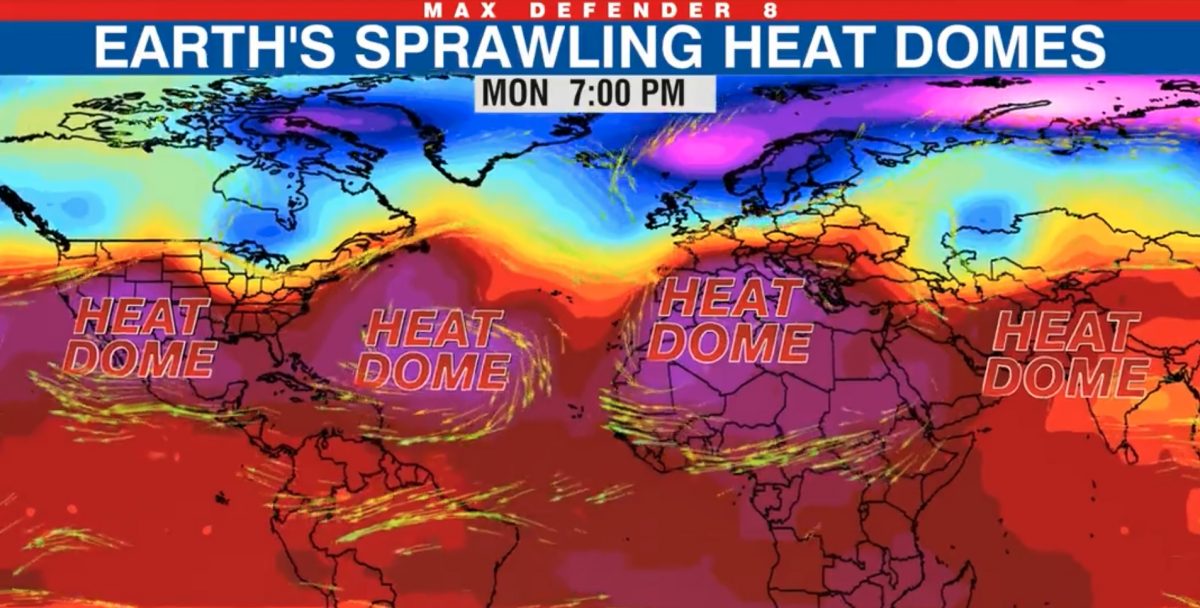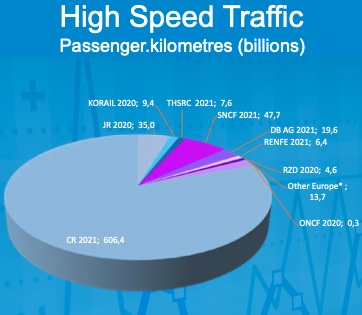The above image shows four major heat-domes over the northern hemisphere this week. Credit @WeatherProf via Umair Haque
The climate crisis we’re living through this year is real. It’s global. And it’s just a foretaste of what humankind will see over the years ahead if the leaders of our most powerful governments don’t find a way, SOON, to work together to address it.
The impact of this crisis (actual, and forecast) puts the conflict in Ukraine that has dominated the attention of Western media for so long now into a much more realistic and sobering perspective. From a global point of view, the conflict in Ukraine is yet another localized tiff between different factions in that tiny (< 12%) portion of humanity that is of European heritage. And by contrast with the two larger intra-European conflicts of the 20th century, this time around most of the rest of global humanity is actually very little involved. During the two intra-European wars of the 20th century, the global reach of that era’s European empires brought hundreds of millions of non-Europe directly into the hostilities—as combatants, as conscripted labor, or as direct or indirect victims of the conflict.
This time, not nearly as much. This time, quite appropriately, the reaction of the vast majority of non-“Western” governments and peoples to the intra-European conflict in Ukraine is mainly: meh.
It’s not that the Ukraine conflict hasn’t harmed the peoples of the Global South. It has. The main ways it has done so have been:
- Some early disruptions in supplies of food, oil, and other commodities, though those disruptions (and the resulting price rises) have now been largely evened out through workarounds.
- Further exacerbating West-vs.-Rest tensions that were already high before February 2022 thanks to factors like: the legacies of colonialism and neo-colonialism; the demonstrated cruelties of sanctions and tariffs; Western selfishness as shown during the Covid crisis, and so on.
- Raising the risk of global nuclear war back to levels unseen since the U.S.-Soviet Cold War. (Not that the countries of the Global South can do anything to reduce this risk. But they suffer from the elevation in global tensions, anyway.)
- Causing a very serious, possibly even fatal, distraction from the kind of global effort that’s needed to address the climate crisis that today, very evidently, is facing us all.
Of those bad global impacts of the conflict in Ukraine, the last is by far the most serious.
But I also want to underline a few basically good consequences that the Ukraine conflict has had for the peoples of the Global South:
- It abruptly added the economically significant country of Russia to the list of those countries facing tight economic sanctions by “the West”, thereby considerably strengthening the efforts that many previous members of “Team Sanctioned” had been working on, to find ways to conduct international trade free of the shackles of Western control over their actions.
- It has revealed that the kind of effortless hegemony that Washington and its Western allies have exercised since 1945 over many areas of global governance is now largely a “paper tiger”. Western nations may have been able to win two or three votes at the U.N.General Assembly that sharply criticized Russia’s actions in Ukraine. But they have been quite unable to persuade mo0st governments of the Global South to sever their economic or political ties to Russia. Meanwhile, with Western arms and war-fighting techniques now proving incapable of winning the battles in Eastern Ukraine, the intimidatory mystique that Western militaries once enjoyed (and flaunted) across and against the Global South has been seriously punctured.
- It has thereby considerably strengthened the various campaigns the governments of the Global South have been undertaking to build international organizations that prioritize their developmental and political needs rather than those of the rich nations of the “West”. Of these various organizations—the BRICS, the SCO, the G-20, etc—the BRICS is now emerging as the key one. (I wrote a little about this last month here, and spoke about it in this recent webinar.)
In this latter regard, one big upcoming event to watch out for will be the upcoming BRICS summit, scheduled for late August, in South Africa. That summit may well end up quadrupling the number of states that are part of this grouping and institutionalizing many new mechanisms within it for addressing economic and political issues worldwide.
I recognize that some of the categories I’ve used above are a little fluid. For example, much or most of Russia is geographically part of Europe, and I have several times heard people from, e.g., West Asia point out that Moscow is actually “West” of them. Australia and Japan are certainly not located in Europe, and most of Japan’s cultural heritage is decidedly non-European. But personally, I would generally count both those countries along with Aotearoa/New Zealand as part of “the West”… And then, what about NATO founding member Türkiye?
Nonetheless, despite those relatively minor bits of fuzziness at the boundaries, I still think the distinction between the “West” and the “Rest”, or between the “West” and the Global South is still analytically useful.
Geopolitics, the blame game, and the climate crisis
So now, let’s dive into the current climate crisis and the wealth of political issues and fissures that underlie it. On Tuesday, I was writing here about the often hortatory (= lecturing) tone that U.S. climate czar John Kerry and other members of the Biden administration have used in describing the nature of their interactions with China on climate issues. That was in the context of Kerry having been in Beijing this week to discuss climate issues with officials there.
And I had stacked those U.S. officials’ utterances/judgments up against China’s actually impressive performance on (a) its development of renewable energy sources and (b) the concrete plans it has for reducing CO2 emissions to zero by 2050. If you haven’t yet seen the highly informative graphs I included in that earlier essay, then you should!
Today I want to add as a footnote to that material, this report that on Wednesday Chinese president Xi Jinping stressed to a high-level gathering of his officials that,
China’s commitments [on reducing or eliminating CO2 emissions] are unswerving, but the path towards the goals as well as the manner, pace and intensity of efforts to achieve them should and must be determined by the country itself, rather than swayed by others…
[We should] actively and steadily work toward carbon peaking and carbon neutrality, foster a clean, low-carbon, safe and efficient energy system, accelerate the formation of a new power system and strengthen the country’s capability of guaranteeing oil and gas security…
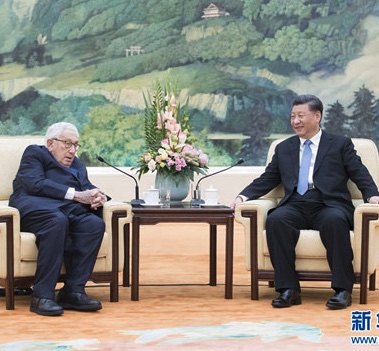
Pres. Xi notably did not meet in person with Kerry. But intriguingly, he (and China’s sanctioned-by-Washington Defense Minister Li Shangfu) did meet this week with the now-centenarian former Secretary of State Henry Kissinger…
In the essay I wrote Tuesday, I noted that China’s annual level of CO2 emissions is currently twice as high as that of the United States—a point that has repeatedly been mentioned in the corporate media here… But I added these important caveats:
- Since China’s population is four times as great as the United States’, China’s per-capita emissions rate is actually half that of Americans’.
- China also bears only half the level of responsibility that the United States does, for the “historic” emissions of CO2 over the past 170 years that continue to poison our atmosphere.
- China has a concrete plan to reduce its CO2 emissions to zero by 2050, including through using and then discarding some reliance on coal-generated energy to act as a crutch as it continues its already impressive building of wind and solar generating plants.
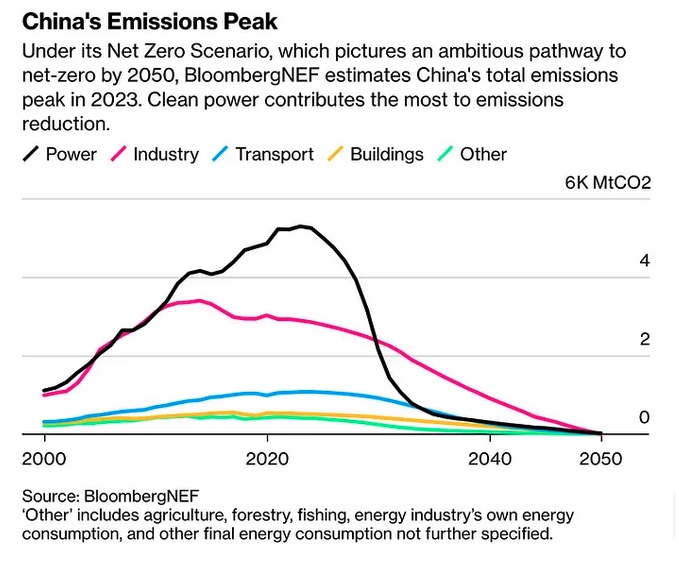
Here, once again, is a key graphic I used there, produced by BloombergNEF, that shows China’s plan for educing its GHG emissions to zero by 2050. The United States, meanwhile, forecasts that its own emissions will continue to rise slightly between now and 2050.
Please go to my earlier essay to see all the sources I cited there, including this crucial report (PDF), “Race to the Top: China 2023”, that was recently released by the California-based NGO Global Energy Monitor (GEM).
In the remainder of today’s essay, I want to dig a little deeper into what China has been using all this electricity for in recent years, and what it might be planning to use its electricity for in the years to come.
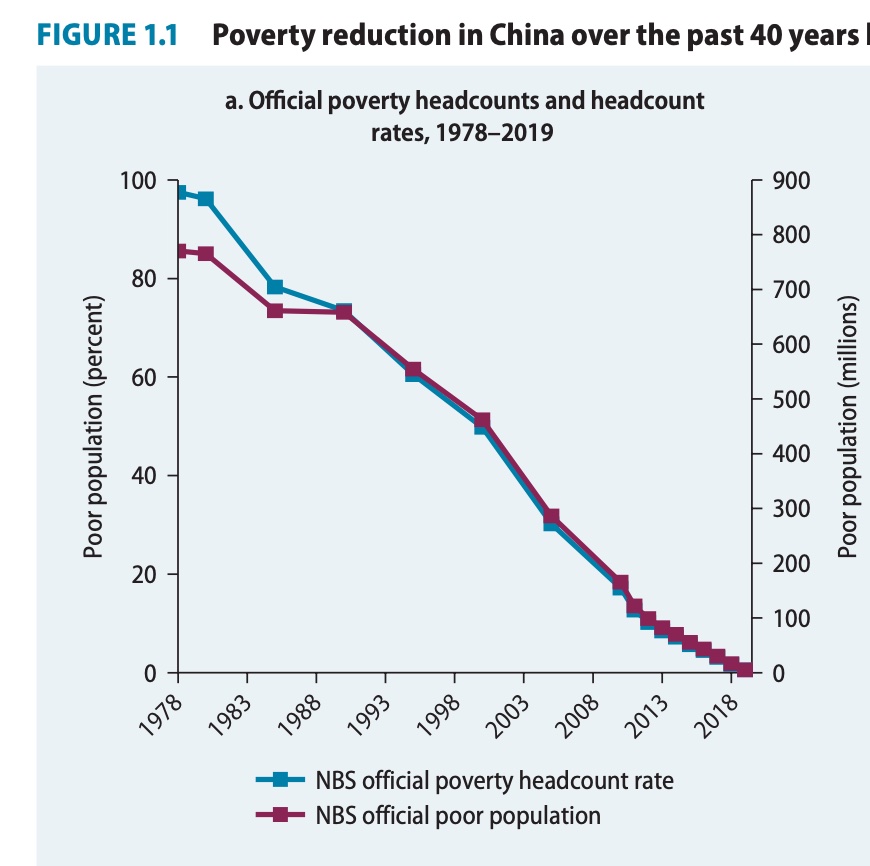
The first and most central fact to note is surely China’s record of having, between 1978 and 2018, lifted 800 million of its people out of poverty. To learn more about how it did this, you can read the report referenced here, which was issued in April 2022 by the (as it happens, US-dominated) World Bank.
That news release on the World Bank website summarizes the report’s findings as follows:
China’s approach to poverty reduction has been based on two pillars… The first was broad-based economic transformation to open new economic opportunities and raise average incomes. The second was the recognition that targeted support was needed to alleviate persistent poverty; support was initially provided to areas disadvantaged by geography and the lack of opportunities and later to individual households. The report points to a number of lessons for other countries from China’s experience, including the importance of a focus on education, an outward orientation, sustained public investments in infrastructure, and structural policies supportive of competition.
The report also highlights how the success of China’s economic development and the associated reduction of poverty benefited from effective governance, which helped coordinate multiple government agencies and elicit cooperation from non-government stakeholders.
Of the factors that the World Bank report listed, I want to highlight here the authors’ identification of sustained public investment in infrastructure as having made a key contribution to China’s astounding record of poverty reduction. And I’m going to focus in particular on the transportation sector, since personal mobility and the efficiency of freight-transport systems are well-known to make an important contribution to poverty reduction—and also, to a more generalized sense of human flourishing.
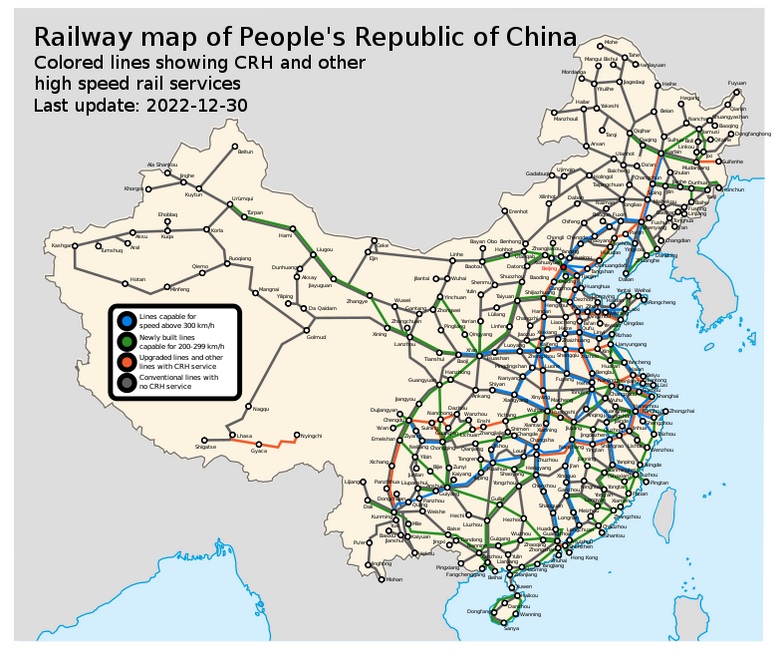
In this essay, which I published a few months ago, I had noted China’s impressive construction of a vast and dense system of high-speed rail lines.
For that essay, I also mined the 2022 edition (PDF) of the annual report of the Union Internationale des Chemins de fer (UIC)to find a pie-chart, left, that shows that passengers on China Rail traveled more than 605.4 billion passenger-kilometres on CR’s high-speed rail system. That was more than 75% of all the passenger-kms traveled by passengers on all the high-speed rail systems around the world.
I also used that UIC report to calculate that while passengers on all of China Rail’s trains (high-speed and non-high-speed) traveled a total of 946.5 billion passenger-kms, passengers on U.S. rail systems traveled less than 3.6 billion p-kms, total. This matters, since rail travel is by far the most energy-efficient and least polluting of all forms of long-distance travel.
In the United States, a high proportion of people traveling from, say, Washington DC to Boston would choose to fly rather than taking even the allegedly “high-speed” Acela train, which traverses the 457-mile route at an average speed of 65 mph, or 105 kph. China’s very much denser high-speed rail system starts at 200 kph and has many trains that travel at more than 300 kph. (China is now also developing a mag-lev train system that may travel at up to 1,000 kph…)
If I wanted to travel by train from Washington to Chicago, it would take more than 17 hours. Washington to Denver: > 41 hours. Washington to Los Angeles: 86 hours. You get the picture, and can see why nearly everyone would opt to fly between these U.S. cities, instead.
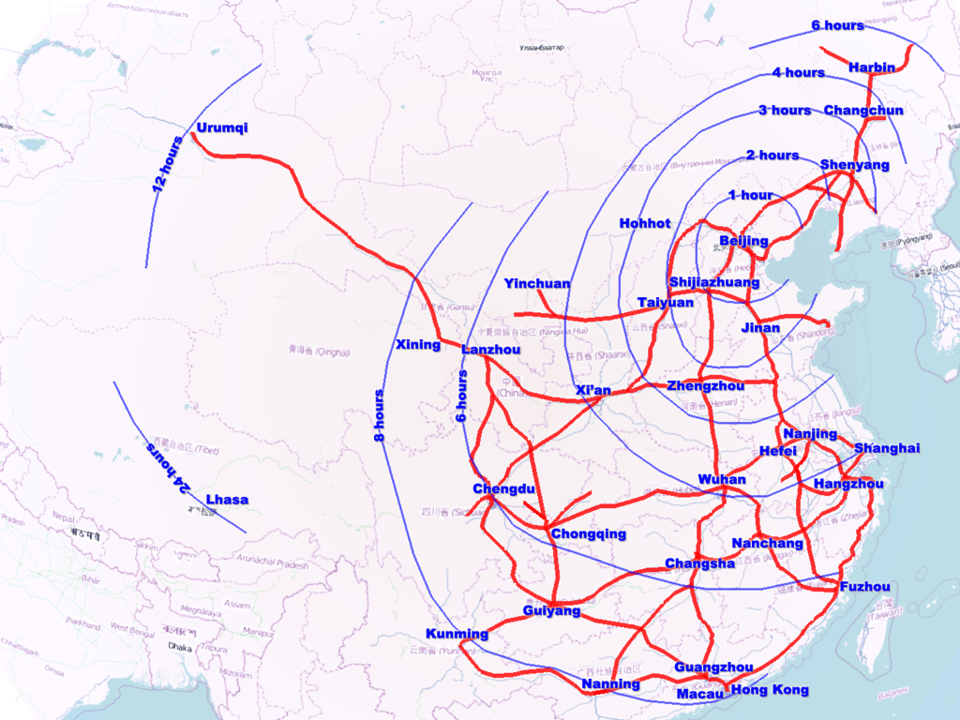
By contrast, this fascinating map shows the estimated high-speed rail travel times from Beijing to a variety of cities throughout China. Less than 4 hours to Shanghai or Xi’an; 8 hours to Hong Kong, Guangzhou, or the ASEAN travel hub of Kunming; 12 hours to Urumqi. Generally, why put up with all the hassle involved in air travel, if you can travel this way instead?
All the inter-city air travel that’s undertaken within the United States adds up. The U.S. Dept. of Transportation’s 2022 report (download the PDF here) noted in Table 1-3 that in 2019, the last year before the pandemic, passengers traveled 752.8 billion passenger-miles, or 1,203 billion passenger-kms, on domestic airplanes.
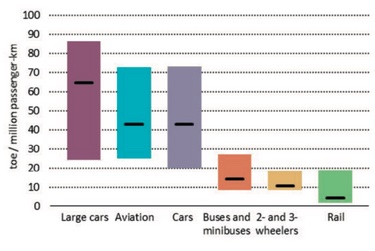
Let’s say that with a good, strong high-speed rail system, half of those passenger-kms could have been traveled by train? The differential in use of tonnes of oil equivalent between these two modes of transport (black bar to black bar on the chart at right) is roughly 38 toe per million passenger-kms. Hence if half of the passenger-kms traveled on U.S. domestic flights were traveled instead by rail, that would save (601,500 x 38) tonnes of oil equivalent… Equals 22.85 million tonnes of oil equivalent.
That thought experiment about the climate burden of the United States’ heavy reliance on aviation for inter-city travel is just one of the many ways in which the policies the country has used to develop (or in some cases, actively de-develop) its physical infrastructure over the past 100 years has left it as a gas-guzzling, high-emitting place in which a strong majority of households are totally reliant on cars in order to conduct the routine business of their members’ daily life.
Two other graphics from the U.S. DOT report cited above help expand this picture. Table 2-3 shows that in 2019, the last year before the pandemic, 75.92% of working Americans reached their workplace by driving alone in a car, whereas only 4.96% used any form of public transportation:
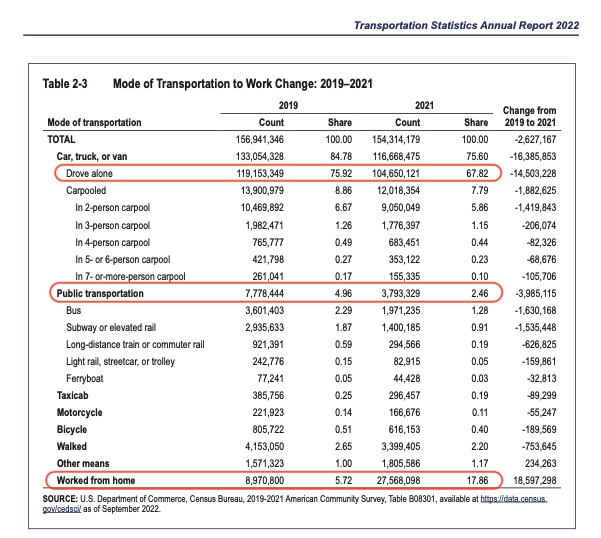
And this graphic shows that in 2021, 59% of U.S. households owned two or more vehicles, while only 8% owned no vehicles:
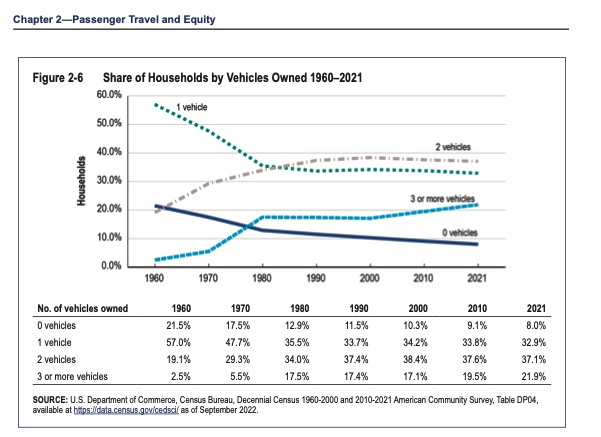
Under these circumstances, the idea that a U.S. envoy might dare to go and “lecture” China on how to reduce its climate footprint is bizarre beyond belief.
There is one broader, world-historical point I want to make here. According to the figures given in this 2021 New York Times article China, with its population 1.4 billion, had as of 2021 been responsible for just 13.9% of “historical” CO2 emissions worldwide, while the United States (population 335 million) had been responsible for 24.6% of historical emissions. Pres. Xi Jinping and other Chinese leaders currently state they are committed to reducing the countries emissions of zero by 2050 and to implementing that plan in a way of their own choosing. For some time, as they admit, that will involve using coal-fired generating plants and other sources of climate-harming emissions.
But what will they be using all that power and energy for over the coming 27 years? It is clear, based on their past record and their own published plans, that the vast majority of the non-clean energy they use will be devoted to two goals:
- Further intensifying their construction of massive renewable-energy installations (wind and solar), as well as of battery systems and other power-storage systems. Constructing those installations does take an investment of energy. Once constructed, however, the maintenance costs of most such installations are extremely low.
- Continuing their development of climate-resilient, energy-efficient physical infrastructure, including rail lines and relatively concentrated housing and other structures that do not “strand” their citizens, as so many U.S. citizens have been stranded, in vast reaches of car-reliant sprawl.
I realize that, talking of sprawl, this essay has already done some interesting shape-shifting since I started writing it two days ago… But in a very real way, all these issues are indeed connected. If the need to address the current extreme climate crisis is paramount, then we have to pursue new ways of thinking about the planet that all 8 billion of us call home. Shoveling ever more weapons (and human lives) into a combat zone in a small corner of Europe is the last thing anybody should be doing! Those weapons themselves are serious emitters of greenhouse gases and other toxins. But much more damagingly, the conflict in Ukraine has greatly exacerbated international tensions and distracted the attention of world leaders from the always-urgent and now long-recognized need to bring the climate crisis under control.
One notable aspect of the exacerbation of global tensions has been the continuing march of the U.S. political elite into a state of intense competition with, or even hostility toward, China. This is evident in the actions of the Biden administration. It is very evident among both parties in Congress. And it is increasingly evident in the way that corporate-media organs and pundits frame, report on, and opine about China. The idea that Americans might cooperate with China in order to combat the climate crisis, or that we might even (gasp!) be able to learn something from China about prudent ways to deal with climate-related issues and infrastructure planning, have come to seem increasingly “extreme” within this country’s ever more intolerant political culture.
Hence, the need I have felt to dive more deeply into all these issues. (If you support my work on this, it would be great if you could make a donation to Just World Educational, so we can keep Globalities.org alive.)

